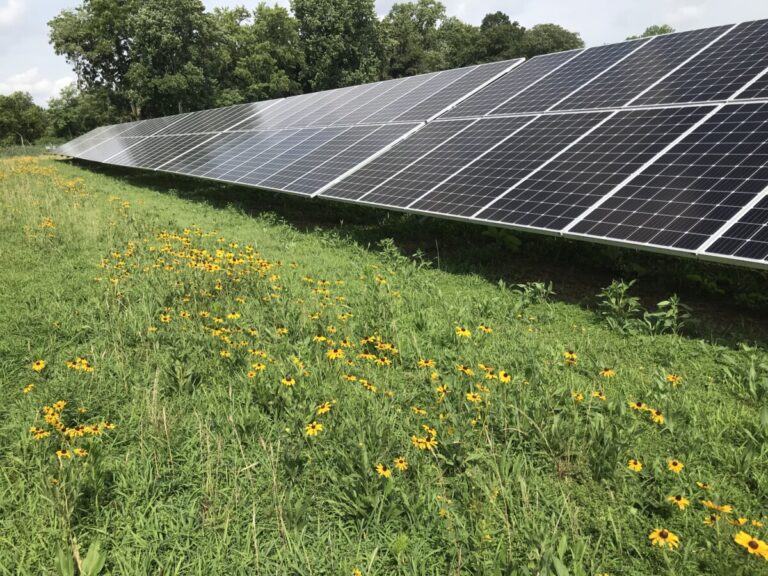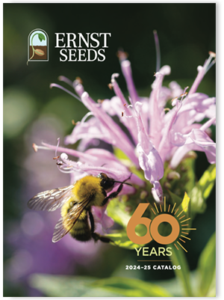Ernst Conservation Seeds is working with the Clifton Institute with the support of Monarch Vegetation Services to determine how to grow native species in Virginia in a way that makes them economically viable. The article originally appeared in the Virginia Mercury. Written by Charlie Paullin.
Click Here for Original Article
A state agency may make it easier to stop and smell the flowers by encouraging the planting of more native pollinator species around solar developments.
This month, the Virginia Department of Conservation and Recreation awarded the state’s second Pollinator-Smart certification, a designation given to solar developers that plant native pollinator species alongside solar projects.
It’s been a slow start for Pollinator Smart, a voluntary state program that’s been in operation for three years. Some solar developers say they support the idea behind Pollinator Smart but in practice face challenges carrying out its requirements, such as ensuring plants don’t block the panels. Still, some localities require the certification.
“I think the fact that it’s not mandated is why it’s taking some time to get traction,” said Rene’ Hypes, a project coordinator with DCR. “But I think as awareness is increasing, I think that is increasing the consideration for doing this.”
The certification process could be altered to achieve more success, said Bryan McKnight, a landscape planner with Timmons Group, an engineering and design firm used by many solar developers and local governments, but “I think having this as a required practice makes sense.”
As solar development has boomed across Virginia, a majority of localities have begun to encourage developers to plant pollinators alongside their panels, but Louisa County and Patrick County are among the four that mandate that projects get the Pollinator-Smart certification because of the agricultural and ecological benefits it provides.
“Anything we can do to promote pollinators is important for an agricultural community,” said Tom Egeland, senior planner with Louisa County. “The purpose for putting it in the code was to support agricultural pollinators.”

While John worked, ground-mounted solar panels were silently converting light from Earth’s “old Sol” directly into electricity for nearby schools, businesses and residents, as well as generating revenue that pays ecologists to manage the flowering Yarrow, Blue-eyed Mary, Oregon Sunshine, Rose Checkermallow and other ground cover throughout the site.
The pollinator program
The Pollinator-Smart certification began as a way to conserve biodiversity as solar development increased. It began in Virginia in 2019, based on other programs around the country.
Certification is awarded to developers who achieve a high enough score on a state rubric that examines whether they have implemented practices to promote pollinators such as planting certain native species under solar panels, in wide-open areas and as fenceline buffers.
“The committee tries to work with the applicant to make this work for their project, “Hypes said. “It’s really a back and forth.”
The department points to a host of ecological benefits associated with the establishment of pollinators in solar fields. Besides providing diverse plant species, pollinators tend to have deep root systems that can help with stormwater management and can foster micro-climates that provide a cooling effect for increased solar production. Comparatively, a solar field that has grass under it may require more maintenance like mowing.
“We’re talking about a huge opportunity,” Hypes said. “Aesthetically also. Think about a solar site that has flowers blooming from spring through fall compared to a site that has turf grass, and gravel and dirt areas for roads and access.”
The Pollinator-Smart certification is designed for utility-scale solar facilities, those that generate 5 or more megawatts of electricity. In Virginia, each megawatt of solar capacity on average requires just under 10 acres.
Deron Lawrence, senior director of natural resources permitting and policy at Boston-based renewables company Longroad Energy, which received the second certification from DCR for its project in Halifax County, said for solar companies, the certification can show communities they’re committed to ensuring projects are ecologically beneficial.
“I think that does help when we get into a new place, a new environment, you can point to it and say that does more good for the community, for biodiversity, for a number of different items,” Lawrence said.
Virginia’s largest electric utilities, Appalachian Power Company and Dominion Energy, say they are interested in the program.
Appalachian Power spokeswoman Teresa Hall said the company is hoping to take ownership later this year of a solar facility under construction in Amherst County, and “if all goes as planned with that arrangement we are interested in participating.”
Dominion spokesperson Tim Eberly said the utility, which acquired the Longroad Energy project in Halifax, has been working on pollinator habitats around electricity infrastructure through a program called “Wings at Work.” However, said Eberly, there are some challenges with creating pollinator habitats at solar facilities.
Potential changes to the program
Professionals in the solar development field point to some of the practical hurdles in receiving the certification.
For one, some pollinators can grow tall enough to block a solar panel’s ability to capture sunlight to generate electricity, said Jeff Hammond, director of project development at Charlottesville-based Apex Clean Energy, a renewable energy developer. He also said there isn’t a robust seed-mix market to provide the native pollinator species companies must use for the certification.
“It’s not a perfect program,” said Hammond. “It’s not as easy as it sounds.”
Solar developers can rack up points on the state’s scorecard by not using insecticides, conducting public engagement and research and preserving wetlands and forests, explained McKnight. But the program’s requirement for plant diversity in areas under solar panels is a challenge, he added. It could be addressed by raising panels to three feet off the ground, which increases the number of plants developers can use that are less costly and otherwise would block the panels.
“If we can get three feet of clearance for the plants, it really opens up our options,” McKnight said.
For the seed mix used for the planting, Ernst Conservation Seeds is working with the Clifton Institute, an environmental research center, to determine how to grow native species in Virginia at a scale that makes them economically viable, said Andy Ernst, vice president at the family company.
Part of the challenge is setting the “ecotype” zone, or boundary for a region that a plant must be from to designate it as native to that area, Ernst said. A pilot program by Ernst Conservation Seeds and the Clifton Institute would designate three general ecotypes in Virginia: coastal, piedmont and mountainous. Three pollinator species — milkweed, mountain mint and grey goldenrod — are native across all three.
Getting the program to the right economies of scale is “going to be a couple years,” said Ernst. “I’m hoping it can be five or less.”
Local government support
While several of Virginia’s localities encourage solar developers to establish pollinator habitats, others like Patrick County make it mandatory. Patrick County Planning Commission Chairman Larry Cowley put the reason for the requirement simply: “We’re concerned about the environment.”
Egeland, the Louisa County planner, said Louisa got the idea for requiring pollinator planting from an American Planning Association article titled “Are you solar ready?” To “put their toe in the water,” Egeland said the county decided to mandate that only 10% of a project receive the certification, which sets the standards for any broader effort.
“Otherwise we’re just saying, “Hey, just throw some pollinators out there,”‘ said Egeland. “We want to go with the state agency that’s going to set a list of requirements.”
Requiring the certification as part of the local approval process could ensure it is awarded more, said Robin Ernst, president of Monarch Vegetation Services, Inc., a Pennsylvania-based company involved with planting pollinator seeds, and Andy Ernst’s sister.
“That makes the biggest difference, what the county is requiring for their permits,” she said.


